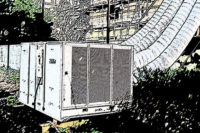Radiant HVAC — what is it? Heating is done in three ways in buildings — convection, conduction, and radiation. Heating and cooling with air is common in most building HVAC systems. Heating and cooling with conduction is not really practical in building HVAC systems. Radiant HVAC is being used more and more in today’s buildings.
Going back to the basics of heat transfer: Heat travels from the hotter body to the cooler body. Radiant HVAC embraces this basic engineering principle. Put a cold panel in a room, and the heat from the warm human body radiates to the cold panel, causing the human to feel cool. If there is a differential in temperature between two bodies, there will be heat transfer by radiation. Heat transfer can be used to cool and not just to heat in HVAC systems, although to be more precise, it is really not conditioning the air as in the HVAC term letters of “AC.”
ASHRAE terminology definition: Heat Transfer — transfer of energy, induced by a temperature difference. May occur by conduction, convection, radiation, mass transfer, or any combination of these.
Applications
Radiant heating applications range from industrial to commercial to institutional to residential. Radiant cooling can have applications in all of these types of buildings, but it is not likely to be as widely used in industrial or residential facilities. Radiant HVAC can be used in both new and retrofit applications.
Industrial. Many industrial buildings have areas were people are concentrated in work spaces and need spot heating and cooling. This is a great application for radiant heaters to direct heat on the people and not waste energy with heating large volumes of air.
Commercial. In commercial buildings, such as offices and hotels and other public facilities, there are a few applications for radiant heating that are often overlooked. In offices, the entry areas are where many kiosks or information desks are located. With this in mind, there is often an opportunity for drafts to occur from doors opening. Radiant heaters would resolve this possible comfort problem. The same would be true with a hotel or a retail store where the checkout lanes are near doors that are continually opened during a busy season like Christmas.
Institutional. Health care facilities are certainly great candidates for radiant heating and cooling. More hospitals are realizing that radiant HVAC can minimize airborne contaminant migration due to less airflow turbulence in a patient room. Patients in a bed like warmth, and radiant can provide comfort without drafts. In addition to radiant heating from ceilings, health care facilities can be a great fit to consider floor radiant heating. Another application that has actually been made a part of some codes is radiant heat for ice/snow control in emergency areas where slip-and-falls can be a liability for the patient and the facility owner if more traditional maintenance is not done to keep the walking surfaces dry.
Residential. Although many HVAC engineers may not do residential work, some do work on large homes that actually use small commercial type HVAC systems. Radiant heat is arguably the most comfortable type of heat in a home, whether it is used from the ceiling or the floor. At a minimum, the investment of radiant heat in a shower or tub dry off area is a huge benefit over standing barefoot on a cold tile floor. Radiant heating in residential applications is a growing market as comfort is becoming a focus as well as residential IAQ.
Architectural Considerations
Radiant HVAC may also be an attractive option when the building architecture is concerned with the integration of HVAC products with other interior design objectives. Radiant panels can be easily integrated into very nice ceiling, wall, or floor assemblies.
Why Radiant?
Radiant HVAC can be more efficient and effective than conductive or convective heating in many applications. Many engineers start off a design with the SOS (Same Ol’ System) concepts that they are familiar with and don’t look at the benefits of radiant systems. Engineers who have designed radiant systems and facility owners who have experienced it understand the benefits from a performance perspective as well as from first- and operational cost angles.
From a total building system perspective, radiant HVAC can be used effectively to “decouple” the building skin load from the rest of the interior, which essentially takes the interior zone for the air system out to about a foot from the outside wall, instead of the normal rule-of-thumb of 10 to 12 ft. This has been done very effectively in large high-rise buildings, especially using radiant heating panels that are controlled with sensors that take heat gain into account.
Radiant Heating Source
Radiant heating is generally gas, electric, or water source from heated (or cooled) water. Electric is typically used in smaller applications where gas or heated water is not available. Gas is generally used in the industrial or commercial warehouse type applications where gas is readily available as the primary energy source.
In many of the larger radiant flooring systems, the “energy” source at the panel is hot water. The water is heated by solar, gas, electric, or maybe a steam-to-water heat exchanger. Water is great for underfloor comfort and freeze control systems. These systems allow for multiple zones to be controlled since the water piping and zone valves are easily installed with minimal cost increase to the system.
Radiant Cooling
Radiant cooling is somewhat like reverse logic. An engineer has to step back and get to the essence of the fundamentals of “heat transfer.” Radiant heat flows from the warmer object to the colder object. In the case of radiant cooling, the heat flows from the human body to a cooler surface. It is like standing in front of a cold window on a winter day or in front of a cold cooler at the grocery store when the door is open to all of the frozen food products. You “feel” the cool but in reality your body is transferring energy to the colder surfaces.
Radiant cooling is a fast-growing option among engineers who are starting to see the advantages while meeting all of the current codes and standards. Chilled beam products on the market are receiving increasing attention from engineers and building owners because they work great when properly applied, installed, operated, and maintained. And they save energy and provide superior comfort in many applications. Although the term “chilled beams” somewhat implies radiant cooling, they are not radiant cooling type products. Chilled beams use chilled water coils to cool the entrained air from the room. Chilled beams can be active or passive, depending on how the ventilation air is handled in the total building HVAC system. In active systems, the ventilation air comes through the chilled beam terminal device. In passive systems, the ventilation comes to each space through a separate ducted system to space air diffusers.
The major chilled beam manufacturers have a diverse product offering along with application and design guides to help engineers and building owners understand how to incorporate and operate the products.
There are manufacturers of complete radiant cooling ceilings similar to radiant heating ceilings. In some applications, the same ceiling system can be used for both heating and cooling as the water temperature changes as the season changes. These systems can be either two-pipe or four-pipe, depending on the building zone control needs.
Some applications could conceivably use radiant flooring in a similar manner as a radiant ceiling for both heating and cooling. Engineering principles need to be clearly understood in design and installation and operation to optimize the benefits of systems without having condensation issues. It takes creativity and good interdisciplinary coordination of engineering and architecture and installation trades to get the best results of combination radiant heating and cooling products with architectural components.
Controlling radiant cooling systems takes a clear understanding of the room and building psychrometrics. It also takes knowledge of how the building will be used by the owner over time with respect to unoccupied setbacks and ventilation air thermal control. Humidity needs to be understood, measured, and controlled in order to prevent condensation on the surfaces of the terminal devices.
Design Considerations
As with any HVAC system, the utilization of radiant heating and cooling involves some application, installation, and product control considerations.
For heating applications, the design considerations start with understanding the scope of the system and the products on the market that are available with the energy source available. Location of hot surface products takes a clear understanding of the intended environment. Gas heaters can be dangerous if placed where someone could touch them or where someone could be too close for a long period of time.
For radiant cooling panels the design must take into account both the airflow and the water flow. The design must take into account the space control of both temperature and humidity. When a building is designed for unoccupied “setback” mode, the controls need to take into account the startup cycle to ensure that the humidity is controlled in a manner that does not cause condensation on the radiant panel terminal units.
Installation Considerations
As with any radiant HVAC system, whether heating or cooling, it takes time to understand from an installation point of view. Obviously, the product manufacturer’s installation recommendations and instructions need to be reviewed and heeded at the time of design, but certainly at the time of installation, too. Performance of radiant products is a function of angles and distances.
Conclusions
Radiant heating and radiant cooling as part of a total HVAC strategy can work very well when the criteria are clear from the beginning of a project, and this category of equipment hosts a healthy variety of product options.
Engineers and building owners are starting to get back to the basics and appreciating that radiant heating and cooling can indeed be a best choice for an array of projects. Comfort is becoming a higher priority again after years of focus on ventilation and energy, and as a result, in my experience, radiant tends to come up more frequently and earlier in project discussions than it used to. That trend is helped by an installation that can be less expensive and take up less space without sacrificing that comfort.





